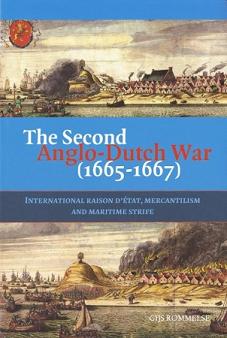
The Second Anglo-Dutch War
Gijs Rommelse
230 pages including index
published in 2006
I'm not sure if in these enlightened times they still do it, but if you ever come across a Dutch naval ship with a broom in the top of her mast and you want to know what's that all about, read up about the Second Anglo-Dutch War and especially the Dutch raid on Medway, when the English fleet was "swept" from the sea. Yes, though these days the Dutch have been reduced to the butt of cheap racist jokes about dope smoking and homosexuality in the English consciousness, there once was a time when Holland was Britain's greatest enemy and competitor, despite the common ground between the two countries. In fact, it was exactly this common ground that was the problem. England and Holland both were dependent on trade for their prosperity, both tried to monopolise the lucrative trade in e.g. spices and it was inevitable that they would fight for supremacy -- it took four wars in total for England to get the upper hand. Of the four wars, the Second Anglo-Dutch War (1665–1667) was the one with the clearest Dutch victory.
Apart from that very general outline however, I knew little about this war, so I'm glad Gijs Rommelse decided to turn his thesis into a proper book. The Second Anglo-Dutch War's main interest lies in determining the causes of the war, how commercial, as well as both foreign and domestic political considerations on both sides drove the countries to war. In process Rommelse also delivers an overview of the war itself, giving short and to the point accounts of all aspects of the war, including the struggle in the Americans and the privatering both the English and the Dutch engaged in. This was after all as much as anything a war about trade.
Rommelse starts his book with an introduction on the conflicting views to the origins of the war, usually ascribed to conflicting commercial interests as England and Holland clashed over control of the newly established colonial trade, as well as more traditional European markets. However, there were other motives playing a role as well, with some historians emphasising the role a new generation of English politicians and courtiers played, as they pursuited a more aggressive stance against the United Provinces as a path to political power. Even religious and ideological differences may have played a role in the road to war. Rommelse tries to synthesise these various explanations into one coherent narrative.
He starts with providing an overview of the European political situation in the years leading up to war and how England and Holland fitted in European power politics. Both court France as a potential ally yet are wary for it as an upcoming competitor, with the United Provinces especially vulnerable. There's also Spain to be considered, much declined in power but still potent, looking for allies against France. Finally there are the lesser powers: Sweden, Denmark, Munster and so on. In the runup to and during the war both combatants attempt to get the support of France or if they can't get that, the lesser powers.
From there, Rommelse looks in greater detail at the political challenges both countries face, first examing the rise of mercantilism in England and the political balance after the Restoration and how these two interacted. A key element in this is the limited space for manoeuvre the Stuart court has, especially financially and how that influenced the decision to go to war. The first Anglo-Dutch War had convinced the English that Holland would be an easy but rich prey, that the war could pay for itself. The United Provinces on the other hand were much less aggressive, attempting to stay neutral in European power struggles, though it was vigilant in defending its trading interests. The goal of Dutch foreign policy in the years between the two wars was to avoid confrontations with either France or England, if at all possible.
As Rommelse shows, the aggressive and confrontational stance of the English made this impossible, with the focus of Dutch policy shifting to preparing themselves for war and getting the support of other European powers, especially France, in which they partially succeed, with France being content to play England and Holland out against each other without taking too much of an active part in hostilities itself.
Once the war does break out, England thinks it will be short and profitable, but though it has the upper hand in the first years, does not succeed in knocking out the United Provinces. England has some success in sea battles with the Dutch fleet, but does not deliver a killing blow, while the attacks on Dutch trade are not nearly as profitable as expected. And Holland meanwhile does its best to damage England's trade in return, with some considerable succes. The Dutch are challenged, but survive and the lack of money and succes eventually force the English to the negotiation tables, though they're not quite committed to honest talks yet. All of which changes after the Medway Raid, as the Dutch manage to destroy a large part of the laid up English fleet, dragging some spectacular prizes home as well. That was enough to get the negotiations going properly. The end result didn't solve the underlying tensions between the English and Dutch, which not many years later would erupt into the Third Anglo-Dutch War, but it did confirm Holland's stature as a great power.
The Second Anglo-Dutch War is a good, concise look at a war that's somewhat more obscure than it should be. Obviously a book of less than 250 pages cannot treat the war in exhaustive detail, but Rommelse does provide a good introduction and broad outline of it that helped me a lot in understanding it. His writing sometimes has a bit of a Dutch flair to it, but that doesn't impede his story.
Webpage created 24-05-2011, last updated 25-06-2011.